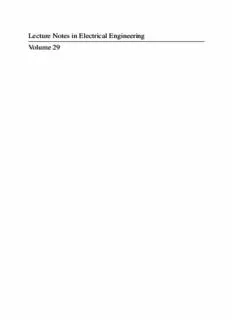
Intelligentized Methodology for Arc Welding Dynamical Processes PDF
Preview Intelligentized Methodology for Arc Welding Dynamical Processes
Lecture Notes in Electrical Engineering Volume 29 · Shan-Ben Chen Jing Wu Intelligentized Methodology for Arc Welding Dynamical Processes Visual Information Acquiring, Knowledge Modeling and Intelligent Control 123 Shan-BenChen JingWu InstituteofWeldingEngineering InstituteofWeldingEngineering ShanghaiJiaoTongUniversity ShanghaiJiaoTongUniversity DongchuanRoad,800 DongchuanRoad,800 Shangahi,200240 Shangahi,200240 PRChina PRChina [email protected] [email protected] ISBN:978-3-540-85641-2 e-ISBN:978-3-540-85642-9 LibraryofCongressControlNumber:2008935359 (cid:2)c Springer-VerlagBerlinHeidelberg2009 Thisworkissubjecttocopyright.Allrightsarereserved,whetherthewholeorpartofthematerialis concerned,specificallytherightsoftranslation,reprinting,reuseofillustrations,recitation,broadcasting, reproductiononmicrofilmorinanyotherway,andstorageindatabanks.Duplicationofthispublication orpartsthereofispermittedonlyundertheprovisionsoftheGermanCopyrightLawofSeptember9, 1965,initscurrentversion,andpermissionforusemustalwaysbeobtainedfromSpringer.Violationsare liabletoprosecutionundertheGermanCopyrightLaw. Theuseofgeneraldescriptivenames,registerednames,trademarks,etc.inthispublicationdoesnotimply, evenintheabsenceofaspecificstatement,thatsuchnamesareexemptfromtherelevantprotectivelaws andregulationsandthereforefreeforgeneraluse. Coverdesign:eStudioCalamarS.L. Printedonacid-freepaper 9 8 7 6 5 4 3 2 1 springer.com Preface Welding handicraft is one of the most primordial and traditional technics, mainly by manpower and human experiences. Weld quality and efficiency are, therefore, straitly limited by the welder’s skill. In the modern manufacturing, automatic and robotic welding is becoming an inevitable trend. However, it is difficult for auto- maticandroboticweldingtoreachhighqualityduetothecomplexity,uncertainty anddisturbanceduringweldingprocess,especiallyforarcweldingdynamics.The informationacquirementandreal-timecontrolofarcweldpooldynamicalprocess during automatic or robotic welding always are perplexing problems to both tech- nologistinweldfieldandscientistsinautomation. Thisbookpresentssomeapplicationresearchesonintelligentizedmethodology in arc welding process, such as machine vision, image processing, fuzzy logical, neuralnetworks,roughset,intelligentcontrolandotherartificialintelligencemeth- odsforsensing,modelingandintelligentcontrolofarcweldingdynamicalprocess. Thestudiesinthebookindicatethatthedesignedvisionsensingandcontrolsys- temsareabletopartiallyemulateaskilledwelder’sintelligentbehaviors:observing, estimating,decision-makingandoperating,andshowagreatpotentialandpromis- ingprospectofartificialintelligenttechnologiesintheweldingmanufacturing. The book is divided into six chapters: Chap. 1 gives an introduction on de- velopment of welding handicraft and manufacturing technology; Chap. 2 mainly addresses visual sensing systems for weld pool during pulsed Gas Tungsten Arc Welding (GTAW); Chap. 3 mainly address information acquirement of arc weld- ing process by image processing methods, including acquiring two dimensional andthreedimensionalcharacteristicsfrommonocularimageofGTAWweldpool; Chap.4mainlyaddressesmodelingmethodsofweldpooldynamicsduringpulsed GTAW, including identification of linear models and nonlinear transfer function modelsofweldpooldynamicalprocess;artificialneuralnetworkmodelsandknowl- edge models for predicting and control of weld pool dynamical characteristics; Chap.5mainlyaddressesintelligentcontrolstrategiesforarcweldingprocess,in- cluding self-regulating PID, fuzzy, PSD controllers, neural network self-learning controllers,model-freecontrollerandcompositedintelligentcontrollersfordynam- ical weld pool during pulsed GTAW; Chap. 6 mainly addresses real-time control of weld pool dynamics during robotic welding process, including intelligentized v vi Preface weldingrobotsystemswithreal-timemonitoringandcontrolofweldpooldynam- ics;andanapplicationofintelligentizedweldingrobotsystems. Theordinalreadingofthisbookhastwooutlines:onereadinglineiscompiled by current outline, i.e., sensing, modeling and control methodology for welding process; the other by classifying of welding technics and conditions, or weld- ing materials, e.g., bead-on-plate, welding with wire filler, gaps variation condi- tions; steel and aluminium alloy welding workpiece. Bead-on plate welding is ad- dressed in Sects. 3.1.2.2, 4.1, 5.3.2. Welding with wire filler is mainly addressed inSects.2.2.2,3.1.2.3,3.2,4.3.3,5.6.4,6.3.Gapvariationconditionismainlyad- dressedinSects.5.4.2,5.6.2,6.4.1.Aluminiumalloyweldingismainlyaddressed in Sects. 2.3, 3.1.3, 3.2, 4.2.1, 4.4.2, 4.4.3, 5.1, 5.2.2, 5.6.3, 6.2.2, 6.3, 6.4. Steel weldingismainlyaddressedinSects.2.2,3.1.2,3.2.3,4.2.2,4.3,5.2.2,5.3.2,5.6, 6.1. TheresearchresultsinthisbookweremainlyimplementedintheIntelligentized Robotic Welding Technology Laboratory (IRWTL), Shanghai Jiao Tong Univer- sity, P R China. The content in the book involves the following doctoral disserta- tions: Dr. Yajun Lou, Dr. Dongbin Zhao, Dr. Guangjun Zhang, Dr. Jianjun Wang, Dr.BingWang,Dr.LaipingLi,Dr.WenjieChen,Dr.QuanyingDu,Dr.Wemhang Li, Dr. Xixia Huang, Dr. Hongyuan Shen, Dr. Chongjian Fan, Dr. Fenglin Lv and Dr.HuabinChen’sworks,etc.Asasupervisoroftheirdoctoraldissertations,Pro- fessorShan-BenChenwouldliketothanktheircontributionstothisbook. We wish to give expression on acknowledgements for the researched works in this book supported by the National Natural Science Foundation of China under GrantNo.50575144andNo.60474036;andsupportedbytheKeyFoundationPro- gramofShanghaiSciences&TechnologyCommitteeunderGrantNo.06JC14036 andNo.021111116. WewouldliketothankProfessorTzyhJongTarnandProfessorLinWufortheir directionsontheresearchworksincludedinthebook.Andlastbutnotleastthank toDr.ThomasDitzngerforhisadviceandhelpduringtheproductionphasesofthe book. Shanghai,China Shan-BenChen JingWu Contents 1 Introduction................................................... 1 1.1 DevelopmentofWeldingandManufacturingTechnology ......... 1 1.2 SensingTechnologyforArcWeldingProcess ................... 3 1.3 VisualSensingTechnologyforArcWeldingProcess ............. 3 1.3.1 ActiveVisualSensing ................................ 4 1.3.2 PassiveDirectVisualSensing.......................... 6 1.3.3 ImageProcessingMethods ............................ 9 1.4 ModelingMethodsforArcWeldingProcess .................... 13 1.4.1 AnalyticalModel .................................... 13 1.4.2 Identification,FuzzyLogicandNeuralNetworkModels ... 14 1.4.3 RoughSetModel .................................... 18 1.5 IntelligentControlStrategiesforArcWeldingProcess............ 19 1.6 TheOrganizedFrameworkoftheBook ........................ 23 References..................................................... 23 2 VisualSensingSystemsforArcWeldingProcess................... 35 2.1 Description of the Real-Time Control Systems with Visual SensingofWeldPoolforthePulsedGTAWProcess ............. 35 2.2 TheVisualSensingSystemandImagesofWeldPoolDuringLow CarbonSteelPulsedGTAW.................................. 38 2.2.1 AnalysisoftheSensingConditionsforLowCarbonSteel .. 38 2.2.2 CapturingSimultaneousImagesofWeldPoolinaFrame fromTwoDirections ................................. 38 2.2.3 CapturingSimultaneousImagesofWeldPoolinaFrame fromThreeDirections ................................ 43 2.3 TheVisualSensingSystemandImagesofWeldPoolDuring AluminiumAlloyPulsedGTAW.............................. 44 2.3.1 AnalysisoftheSensingConditionsforAluminiumAlloy... 44 2.3.2 CapturingSimultaneousImagesofWeldPoolinaFrame fromTwoDirections ................................. 47 2.3.3 CapturingSimultaneousImagesofWeldPoolinaFrame fromThreeDirections ................................ 51 vii viii Contents 2.4 TheChapterConclusionRemarks............................. 54 References..................................................... 55 3 InformationAcquirementofArcWeldingProcess ................. 57 3.1 Acquiring Two Dimensional Characteristics from Weld Pool ImageDuringPulsedGTAW ................................. 57 3.1.1 DefinitionofWeldPoolShapeParameters ............... 58 3.1.2 TheProcessingandCharacteristicComputingofLow CarbonSteelWeldPoolImages ........................ 59 3.1.3 The Processing and Characteristic Computing of AluminiumAlloyWeldPoolImage..................... 69 3.2 AcquiringThreeDimensionalCharacteristicsfromMonocular ImageofWeldPoolDuringPulsedGTAW ..................... 78 3.2.1 DefinitionofTopsideWeldPoolHeight ................. 78 3.2.2 ExtractingSurfaceHeightoftheWeldPoolfromArc ReflectionPosition................................... 79 3.2.3 ExtractingSurfaceHeightoftheWeldPoolbyShape fromShading ....................................... 81 3.3 TheSoftwareofImageProcessingandCharacteristicExtracting ofWeldPoolDuringPulsedGTAW ...........................101 3.3.1 TheFrameworkandFunctionoftheSoftwareSystem......101 3.3.2 TheDirectionsforUsingtheSoftwareSystem............102 3.4 TheChapterConclusionRemarks.............................110 References.....................................................111 4 ModelingMethodsofWeldPoolDynamicsDuringPulsedGTAW ...113 4.1 AnalysisonWeldingDynamics...............................113 4.1.1 TransientResponseswithPulseDutyRatioStepChanges ..115 4.1.2 TransientResponseswithWeldingVelocityStepChanges ..116 4.1.3 TransientResponseswithPeakCurrentStepChanges......116 4.1.4 Transient Responses with Wire Feeding Velocity StepChanges .......................................117 4.2 IdentificationModelsofWeldPoolDynamics...................118 4.2.1 Linear Stochastic Models of Aluminium Alloy Weld PoolDynamics ......................................118 4.2.2 NonlinearModelsofLowCarbonSteelWeld PoolDynamics ......................................123 4.3 ArtificialNeuralNetworkModelsofWeldPoolDynamics ........126 4.3.1 BWHDNNM Model for Predicting Backside Width andTopsideHeightDuringButtPulsedGTAW ...........127 4.3.2 BNNMModelforPredictingBacksideWidthDuringButt PulsedGTAW .......................................130 4.3.3 BHDNNM Model for Predicting Backside Width and Topside Height During Butt Pulsed GTAW BasedonThree-DimensionalImageProcessing...........131 4.3.4 SSNNMModelDuringButtPulsedGTAW ..............133 Contents ix 4.4 KnowledgeModelsofWeldPoolDynamicalProcess ............137 4.4.1 Extraction of Fuzzy Rules Models of Weld Pool DynamicalProcess...................................137 4.4.2 KnowledgeModelsBased-onRoughSetsforWeldPool DynamicalProcessBasedonClassicTheory .............139 4.4.3 AVariablePrecisionRoughSetBasedModelingMethod forPulsedGTAW ....................................150 4.5 TheChapterConclusionRemarks.............................161 References.....................................................161 5 IntelligentControlStrategiesforArcWeldingProcess..............163 5.1 Open-LoopExperiments.....................................163 5.2 PIDControllerforWeldPoolDynamicsDuringPulsedGTAW ....165 5.2.1 PIDControlAlgorithm ...............................165 5.2.2 WeldingExperimentswithPIDController ...............166 5.3 PSDControllerforWeldPoolDynamicsDuringPulsedGTAW....168 5.3.1 PSDControllerAlgorithms............................168 5.3.2 WeldingExperimentswithPSDController...............170 5.4 NNSelf-LearningControllerforDynamicalWeldPoolDuring PulsedGTAW .............................................172 5.4.1 FNNCControlAlgorithm .............................173 5.4.2 ExperimentofFNNCControlScheme ..................178 5.5 Model-FreeAdaptiveControllerforArcWeldingDynamics.......182 5.5.1 PreliminaryofModel-FreeAdaptiveControl(MFC).......184 5.5.2 The Improved Model-Free Adaptive Control with G FunctionFuzzyReasoningRegulation...................186 5.5.3 RealizationandSimulationofImprovedControlAlgorithm.188 5.5.4 ControlledExperimentsonPulsedGTAWProcess ........190 5.6 CompositeIntelligentControllerforWeldPoolDynamicsDuring PulsedGTAW .............................................194 5.6.1 FNNC-ExpertSystemControllerforLowCarbonSteel DuringButtWelding .................................195 5.6.2 FNNC-ForwardFeedControllerforLowCarbonSteel DuringButtWeldingwithGapVariations................200 5.6.3 CompensatedAdaptive-FuzzyControllerforAluminium AlloyDuringButtWelding............................205 5.6.4 Adaptive-FuzzyControllerBasedonNonlinearModel forLowCarbonSteelDuringButtWeldingwithWireFiller 210 5.7 TheChapterConclusionRemarks.............................218 References.....................................................220 6 Real-TimeControlofWeldPoolDynamicsDuringRoboticGTAW ..221 6.1 Real-TimeControlofLowCarbonSteelWeldPoolDynamicsby PIDControllerDuringRoboticPulsedGTAW ..................221 x Contents 6.1.1 Welding Robot Systems with Vision Sensing and Real-TimeControlofArcWeldDynamics ...............223 6.1.2 WeldPoolImageProcessingDuringRoboticPulsedGTAW 225 6.1.3 ModelingofDynamicWeldingProcess..................231 6.1.4 Real-TimeControlofLowCarbonSteelWeldingPoolby PIDRegulatorDuringRoboticPulsedGTAW ............234 6.2 Real-TimeControlofWeldPoolDynamicsandSeamFormingby NeuralSelf-LearningControllerDuringRoboticPulsedGTAW....236 6.2.1 NeuronSelf-LearningPSDControllerforLowCarbon SteelWeldPool .....................................236 6.2.2 AdaptiveNeuralPIDControllerforAluminiumAlloy WeldingPool........................................239 6.3 Vision-Based Real-Time Control of Weld Seam Tracking and Weld Pool Dynamics During Aluminium Alloy Robotic PulsedGTAW .............................................244 6.3.1 WeldingRoboticSystem ..............................245 6.3.2 ImageProcessingDuringtheRobotSeamTracking .......250 6.3.3 SeamTrackingControlleroftheWeldingRobot ..........256 6.3.4 ExperimentResultsofSeamTrackingandMonitoring DuringRoboticWelding ..............................258 6.4 CompoundIntelligentControlofWeldPoolDynamicswithVisual MonitoringDuringRoboticAluminiumAlloyPulsedGTAW......261 6.4.1 TheRoboticWeldingSystemswithVisualMonitoring DuringPulsedGTAW ................................261 6.4.2 ImageObtainingandProcessingforWeldPoolDuring RoboticWelding.....................................262 6.4.3 ModelingandControlSchemeforWeldingRobotSystem..265 6.4.4 Penetration Control Procedure and Results byRoboticWelding ..................................269 6.5 TheChapterConclusionRemarks.............................271 References.....................................................271 7 ConclusionRemarks ...........................................275 Index .............................................................277 List of Figures 1.1 Keytechnologiesinthecontrolsystemoftheweldingprocess...... 2 1.2 Weldpoolimagewiththestroboscopicvisionsensingsystem[48] (a)Schematicdiagram(b)Schematicdiagram ................... 5 1.3 Schematicofsensingtheimageofweldpoolusingstructurallight system[51]................................................. 5 1.4 ThepoolimagewithstructurallightsensingsysteminGTAW[51] (a)Originalimage(b)Stripeskeletonandboundary .............. 6 1.5 Themethodofspectralcensoring[57](a)Intensitydistributionof thespectrallines(b)Imageofweldpool ........................ 8 1.6 MethodofcoaxialweldpoolviewinginGTAW[60](a)Systemset (b)Imageofweldpool....................................... 9 1.7 The neural network models of welding process [158] (a) The forwardmodel(b)Thereversemodel........................... 17 1.8 Fuzzyneuralnetworkcontrolsystemtocontrolthepenetration depth[198]................................................. 20 1.9 Close-loopcontrolsystemofneuralnetworkduringGTAW[162] ... 21 1.10 Closed-loopcontrolsystemofneuralnetworkduringGTAW[189] .. 21 1.11 Principlediagramforself-learningfuzzyneuralcontrolforGTAW process[215] ............................................... 22 2.1 ThestructurediagramofexperimentalsystemforpulsedGTAW .... 36 2.2 Thephotographofexperimentalequipment...................... 36 2.3 Thesensingsystem(a)thephotographofsensingsystem(b)The lightpath .................................................. 37 2.4 ArclightradiationofGTAWwithmildsteelanode.(a)Thespectral distribution(b)arclightradiationflux .......................... 39 2.5 Thelightpathofsimultaneousdouble-sidevisualimagesensing systemofweldpoolinaframe ................................ 39 2.6 AframecompleteweldpoolimageofpulsedGTAW.............. 41 2.7 Thevisualimagesoftheweldpoolindifferenttimeofapulsecycle. 41 xi
Description: